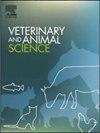Molograph 4.0:一个用于评估马咀嚼过程各方面的非侵入式自动化系统的演示
IF 1.9
Q2 AGRICULTURE, DAIRY & ANIMAL SCIENCE
引用次数: 0
摘要
我们概述了一个监测系统,作为医疗物联网(IoMT)在马身上的演示,该系统提供了记录马咀嚼过程各个方面的能力。在这里,我们提出了Molograph的概念,这个概念早在1941年就由Leue以机械形式提出,并转移到今天的世界。作为一个实质性的实际优势,该系统现在涉及在马熟悉的环境中进行的非侵入性测量。所有病人都喂粗饲料。在检查场景方面,我们着重于确定咀嚼方向。该系统通过自动化耗时和繁琐的观察来减轻考试的压力,而结果与人类观察者的结果相当。首先,用Molograph 4.0检查马可能会提供一些迹象,比如主要的单边咀嚼,这证明兽医需要进行更详细的牙齿检查。专家可以找出根本原因,从而防止像斜切牙错合或剪切口的病理。所有观察到的咀嚼方向的变化都与咀嚼间隙有关,但这种关系不是客观的。本文章由计算机程序翻译,如有差异,请以英文原文为准。

Molograph 4.0: A demonstration of a non-invasive, automated system for evaluating aspects of the masticatory process in the horse
We outlined a monitoring system as a demonstration of the Internet of Medical Things (IoMT) in horses that provided the ability to record aspects of the equine chewing process. Here we take up the idea of a Molograph, which was already proposed in the mechanical form in 1941 by Leue and transferred into today’s world. As a substantial practical advantage, the system now involved a non-invasive measurement that was taken in the horse’s familiar environment. All patients were fed roughage. In terms of the examination scenario, we focused on the determination of the direction of chewing. The system relieves the strain of the examination by automating an otherwise time-consuming and tedious observation, while the results were comparable to those of a human observer. Firstly, examinating the horse with the Molograph 4.0 may provide indications like predominant unilateral chewing that justify a more detailed dental inspection by a veterinarian. The expert may identify the root cause and thus prevent pathologies like diagonal incisor malocclusion or shear mouth. All observed changes in chewing direction occurred in connection with chewing breaks, while the relationship is not bijective.
求助全文
通过发布文献求助,成功后即可免费获取论文全文。
去求助
来源期刊

Veterinary and Animal Science
Veterinary-Veterinary (all)
CiteScore
3.50
自引率
0.00%
发文量
43
审稿时长
47 days
 求助内容:
求助内容: 应助结果提醒方式:
应助结果提醒方式:


